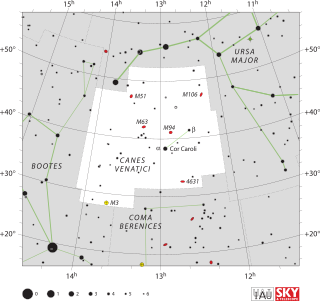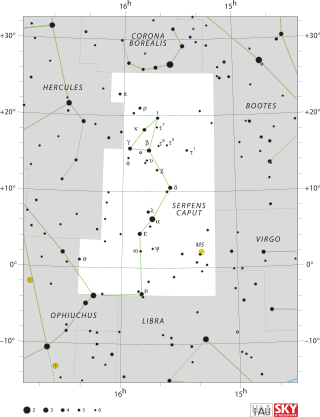This article includes a list of references, related reading, or external links, but its sources remain unclear because it lacks inline citations .(August 2018) |

The International Astronomical Union (IAU) designates 88 constellations of stars. In the table below, they are ranked by the solid angle that they subtend in the sky, measured in square degrees and millisteradians.
These solid angles depend on arbitrary boundaries between the constellations: the list below is based on constellation boundaries drawn up by Eugène Delporte in 1930 on behalf of the IAU and published in Délimitation scientifique des constellations (Cambridge University Press). Before Delporte's work, there was no standard list of the boundaries of each constellation.
Delporte drew the boundaries along vertical and horizontal lines of right ascension and declination; however, he did so for the epoch B1875.0, which means that due to precession of the equinoxes, the borders on a modern star map (e.g., for epoch J2000) are already somewhat skewed and no longer perfectly vertical or horizontal. This skew will increase over the centuries to come. However, this does not change the solid angle of any constellation.
| Rank | Abbrev. | Constellation | Solid angle ("Area") (sq. deg.) [1] | Solid angle (millisteradians) | Percentage | Right ascension (hours & mins) [2] | Declination (degs & mins) [3] | Quad [4] |
|---|---|---|---|---|---|---|---|---|
| 01 | Hya | Hydra | 1302.844 | 396.869 | 3.16% | +11 36.73 | −14 31.91 | SQ2 |
| 02 | Vir | Virgo | 1294.428 | 394.305 | 3.14% | +13 24.39 | −04 09.51 | SQ3 |
| 03 | UMa | Ursa Major | 1279.660 | 389.807 | 3.10% | +11 18.76 | +50 43.27 | NQ2 |
| 04 | Cet | Cetus | 1231.411 | 375.109 | 2.99% | +01 40.10 | −07 10.76 | SQ1 |
| 05 | Her | Hercules | 1225.148 | 373.201 | 2.97% | +17 23.16 | +27 29.93 | NQ3 |
| 06 | Eri | Eridanus | 1137.919 | 346.630 | 2.76% | +03 18.02 | −28 45.37 | SQ1 |
| 07 | Peg | Pegasus | 1120.794 | 341.413 | 2.72% | +22 41.84 | +19 27.98 | NQ4 |
| 08 | Dra | Draco | 1082.952 | 329.886 | 2.63% | +15 08.64 | +67 00.40 | NQ3 |
| 09 | Cen | Centaurus | 1060.422 | 323.023 | 2.57% | +13 04.27 | −47 20.72 | SQ3 |
| 10 | Aqr | Aquarius | 979.854 | 298.481 | 2.38% | +22 17.38 | −10 47.35 | SQ4 |
| 11 | Oph | Ophiuchus | 948.340 | 288.881 | 2.30% | +17 23.69 | −07 54.74 | SQ3 |
| 12 | Leo | Leo | 946.964 | 288.462 | 2.30% | +10 40.03 | +13 08.32 | NQ2 |
| 13 | Boo | Boötes | 906.831 | 276.237 | 2.20% | +14 42.64 | +31 12.16 | NQ3 |
| 14 | Psc | Pisces | 889.417 | 270.932 | 2.16% | +00 28.97 | +13 41.23 | NQ1 |
| 15 | Sgr | Sagittarius | 867.432 | 264.235 | 2.10% | +19 05.94 | −28 28.61 | SQ4 |
| 16 | Cyg | Cygnus | 803.983 | 244.907 | 1.95% | +20 35.28 | +44 32.70 | NQ4 |
| 17 | Tau | Taurus | 797.249 | 242.856 | 1.93% | +04 42.13 | +14 52.63 | NQ1 |
| 18 | Cam | Camelopardalis | 756.828 | 230.543 | 1.83% | +08 51.37 | +69 22.89 | NQ2 |
| 19 | And | Andromeda | 722.278 | 220.018 | 1.75% | +00 48.46 | +37 25.91 | NQ1 |
| 20 | Pup | Puppis | 673.434 | 205.140 | 1.63% | +07 15.48 | −31 10.64 | SQ2 |
| 21 | Aur | Auriga | 657.438 | 200.267 | 1.59% | +06 04.42 | +42 01.68 | NQ2 |
| 22 | Aql | Aquila | 652.473 | 198.755 | 1.58% | +19 40.02 | +03 24.65 | NQ4 |
| 23 | Ser | Serpens [5] | 636.928 | 194.019 | 1.54% | +16 57.04 | +06 07.32 | NQ3 |
| 24 | Per | Perseus | 614.997 | 187.339 | 1.49% | +03 10.50 | +45 00.79 | NQ1 |
| 25 | Cas | Cassiopeia | 598.407 | 182.285 | 1.45% | +01 19.16 | +62 11.04 | NQ1 |
| 26 | Ori | Orion | 594.120 | 180.979 | 1.44% | +05 34.59 | +05 56.94 | NQ1 |
| 27 | Cep | Cepheus | 587.787 | 179.050 | 1.42% | +02 32.64 | +71 00.51 | NQ4 |
| 28 | Lyn | Lynx | 545.386 | 166.134 | 1.32% | +07 59.53 | +47 28.00 | NQ2 |
| 29 | Lib | Libra | 538.052 | 163.900 | 1.30% | +15 11.96 | −15 14.08 | SQ3 |
| 30 | Gem | Gemini | 513.761 | 156.501 | 1.25% | +07 04.24 | +22 36.01 | NQ2 |
| 31 | Cnc | Cancer | 505.872 | 154.097 | 1.23% | +08 38.96 | +19 48.35 | NQ2 |
| 32 | Vel | Vela | 499.649 | 152.202 | 1.21% | +09 34.64 | −47 10.03 | SQ2 |
| 33 | Sco | Scorpius | 496.783 | 151.329 | 1.20% | +16 53.24 | −27 01.89 | SQ3 |
| 34 | Car | Carina | 494.184 | 150.537 | 1.20% | +08 41.70 | −63 13.16 | SQ2 |
| 35 | Mon | Monoceros | 481.569 | 146.694 | 1.17% | +07 03.63 | +00 16.93 | NQ2 |
| 36 | Scl | Sculptor | 474.764 | 144.621 | 1.15% | +00 26.28 | −32 05.30 | SQ1 |
| 37 | Phe | Phoenix | 469.319 | 142.963 | 1.14% | +00 55.91 | −48 34.84 | SQ1 |
| 38 | CVn | Canes Venatici | 465.194 | 141.706 | 1.13% | +13 06.96 | +40 06.11 | NQ3 |
| 39 | Ari | Aries | 441.395 | 134.457 | 1.07% | +02 38.16 | +20 47.54 | NQ1 |
| 40 | Cap | Capricornus | 413.947 | 126.095 | 1.00% | +21 02.93 | −18 01.39 | SQ4 |
| 41 | For | Fornax | 397.502 | 121.086 | 0.96% | +02 47.88 | −31 38.07 | SQ1 |
| 42 | Com | Coma Berenices | 386.475 | 117.727 | 0.94% | +12 47.27 | +23 18.34 | NQ3 |
| 43 | CMa | Canis Major | 380.118 | 115.791 | 0.92% | +06 49.74 | −22 08.42 | SQ2 |
| 44 | Pav | Pavo | 377.666 | 115.044 | 0.92% | +19 36.71 | −65 46.89 | SQ4 |
| 45 | Gru | Grus | 365.513 | 111.342 | 0.89% | +22 27.39 | −46 21.11 | SQ4 |
| 46 | Lup | Lupus | 333.683 | 101.646 | 0.81% | +15 13.21 | −42 42.53 | SQ3 |
| 47 | Sex | Sextans | 313.515 | 95.502 | 0.76% | +10 16.29 | −02 36.88 | SQ2 |
| 48 | Tuc | Tucana | 294.557 | 89.727 | 0.71% | +23 46.64 | −65 49.80 | SQ4 |
| 49 | Ind | Indus | 294.006 | 89.559 | 0.71% | +21 58.33 | −59 42.40 | SQ4 |
| 50 | Oct | Octans | 291.045 | 88.657 | 0.71% | +23 00.00 | −82 09.12 | SQ4 |
| 51 | Lep | Lepus | 290.291 | 88.428 | 0.70% | +05 33.95 | −19 02.78 | SQ1 |
| 52 | Lyr | Lyra | 286.476 | 87.266 | 0.69% | +18 51.17 | +36 41.36 | NQ4 |
| 53 | Crt | Crater | 282.398 | 86.023 | 0.68% | +11 23.75 | −15 55.74 | SQ2 |
| 54 | Col | Columba | 270.184 | 82.303 | 0.65% | +05 51.76 | −35 05.67 | SQ1 |
| 55 | Vul | Vulpecula | 268.165 | 81.688 | 0.65% | +20 13.88 | +24 26.56 | NQ4 |
| 56 | UMi | Ursa Minor | 255.864 | 77.941 | 0.62% | +15 00.00 | +77 41.99 | NQ3 |
| 57 | Tel | Telescopium | 251.512 | 76.615 | 0.61% | +19 19.54 | −51 02.21 | SQ4 |
| 58 | Hor | Horologium | 248.885 | 75.815 | 0.60% | +03 16.56 | −53 20.18 | SQ1 |
| 59 | Pic | Pictor | 246.739 | 75.161 | 0.60% | +05 42.46 | −53 28.45 | SQ1 |
| 60 | PsA | Piscis Austrinus | 245.375 | 74.745 | 0.59% | +22 17.07 | −30 38.53 | SQ4 |
| 61 | Hyi | Hydrus | 243.035 | 74.033 | 0.59% | +02 20.65 | −69 57.39 | SQ1 |
| 62 | Ant | Antlia | 238.901 | 72.773 | 0.58% | +10 16.43 | −32 29.01 | SQ2 |
| 63 | Ara | Ara | 237.057 | 72.212 | 0.57% | +17 22.49 | −56 35.30 | SQ3 |
| 64 | LMi | Leo Minor | 231.956 | 70.658 | 0.56% | +10 14.72 | +32 08.08 | NQ2 |
| 65 | Pyx | Pyxis | 220.833 | 67.270 | 0.54% | +08 57.16 | −27 21.10 | SQ2 |
| 66 | Mic | Microscopium | 209.513 | 63.821 | 0.51% | +20 57.88 | −36 16.49 | SQ4 |
| 67 | Aps | Apus | 206.327 | 62.851 | 0.50% | +16 08.65 | −75 18.00 | SQ3 |
| 68 | Lac | Lacerta | 200.688 | 61.133 | 0.49% | +22 27.68 | +46 02.51 | NQ4 |
| 69 | Del | Delphinus | 188.549 | 57.435 | 0.46% | +20 41.61 | +11 40.26 | NQ4 |
| 70 | Crv | Corvus | 183.801 | 55.989 | 0.45% | +12 26.52 | −18 26.20 | SQ3 |
| 71 | CMi | Canis Minor | 183.367 | 55.857 | 0.44% | +07 39.17 | +06 25.63 | NQ2 |
| 72 | Dor | Dorado | 179.173 | 54.579 | 0.43% | +05 14.51 | −59 23.22 | SQ1 |
| 73 | CrB | Corona Borealis | 178.710 | 54.438 | 0.43% | +15 50.59 | +32 37.49 | NQ3 |
| 74 | Nor | Norma | 165.290 | 50.350 | 0.40% | +15 54.18 | −51 21.09 | SQ3 |
| 75 | Men | Mensa | 153.484 | 46.754 | 0.37% | +05 24.90 | −77 30.24 | SQ1 |
| 76 | Vol | Volans | 141.354 | 43.059 | 0.34% | +07 47.73 | −69 48.07 | SQ2 |
| 77 | Mus | Musca | 138.355 | 42.145 | 0.34% | +12 35.28 | −70 09.66 | SQ3 |
| 78 | Tri | Triangulum | 131.847 | 40.163 | 0.32% | +02 11.07 | +31 28.56 | NQ1 |
| 79 | Cha | Chamaeleon | 131.592 | 40.085 | 0.32% | +10 41.53 | −79 12.30 | SQ2 |
| 80 | CrA | Corona Australis | 127.696 | 38.898 | 0.31% | +18 38.79 | −41 08.85 | SQ4 |
| 81 | Cae | Caelum | 124.865 | 38.036 | 0.30% | +04 42.27 | −37 52.90 | SQ1 |
| 82 | Ret | Reticulum | 113.936 | 34.707 | 0.28% | +03 55.27 | −59 59.85 | SQ1 |
| 83 | TrA | Triangulum Australe | 109.978 | 33.501 | 0.27% | +16 04.95 | −65 23.28 | SQ3 |
| 84 | Sct | Scutum | 109.114 | 33.238 | 0.26% | +18 40.39 | −09 53.32 | SQ4 |
| 85 | Cir | Circinus | 93.353 | 28.437 | 0.23% | +14 34.54 | −63 01.82 | SQ3 |
| 86 | Sge | Sagitta | 79.932 | 24.349 | 0.19% | +19 39.05 | +18 51.68 | NQ4 |
| 87 | Equ | Equuleus | 71.641 | 21.823 | 0.17% | +21 11.26 | +07 45.49 | NQ4 |
| 88 | Cru | Crux | 68.447 | 20.850 | 0.17% | +12 26.99 | −60 11.19 | SQ3 |
- Notes
- ↑ The total solid angle of all constellations is the total solid angle of the sky, which is exactly 4π steradians, or 4π × (180/π)2 = 129,600/π square degrees, or approximately 41,252.961 square degrees. The figures in the table do not sum precisely to this number due to rounding errors, which vanish when the areas are rounded instead to one decimal place.
- ↑ Average of the most eastward and most westward RA.
- ↑ Average of the most northern and most southern declination.
- ↑ "Quad" designates the quadrant of the sky as N for North or S for South, Quadrants 1 (0h–6h), 2 (6h–12h), 3 (12h–18h), or 4 (18h–0h).
- ↑ Serpens is divided into two parts:
Serpens Caput ("Serpent's Head"; 428.484 sq. deg.; midpoint: RA: 15 46.49, Dec: +10 58.20), and
Serpens Cauda ("Serpent's Tail"; 208.444 sq. deg.; midpoint: RA: 18 07.60, Dec: -04 51.73)














